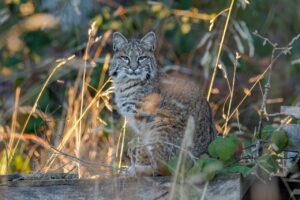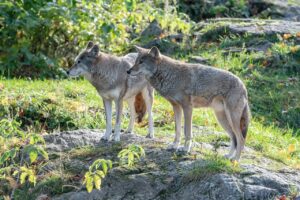Porcupines are wonderful animals who have a unique look. Since these animals are small and seen in the wild, it can be difficult to guess what they sound like.
By the end of this article, you should have your answer to this question and should be able to identify the different sounds they make.
What Sound Does a Porcupine Make?

Porcupines are closely related to other animals in the Rodentia family, such as rats, squirrels, and beavers. So they sound somewhat alike.
Here are some of the sounds that porcupines make:
Chattering
A porcupine will make a chattering sound when they are excited or nervous about something. This sound can also mean that they are warning you to stay away.
This chattering noise sounds like a rapid clicking or gnashing of teeth, and it is meant to intimidate predators or rivals. They might also shake their quills to create a rattling sound that accompanies the chattering.
Whining
A porcupine will produce this soft and high-pitched sound when they are in pain, distress, or fear. It sounds like a whimper or a squeak, and it is usually a sign that the porcupine needs help or wants to escape.
Moaning
This is a low and deep sound that porcupines make when they are relaxed or content. It sounds like a groan or a hum, and it is usually a sign that the porcupine is enjoying something or feeling comfortable.
Grunting
When a porcupine makes this sound, it either means that they are angry or annoyed. It sounds like a snort or a growl, and it is usually a sign that the porcupine is ready to fight or defend itself.
Cooing
This is a soft and gentle sound that porcupines make when they are friendly or affectionate. It sounds like a purr or a murmur, and it is usually a sign that the porcupine is happy or curious.
Listen to Porcupine Sounds
Listen to the video below to find out what a porcupine sounds like.


Why Do Porcupines Make Sounds?
Just like many other animals, porcupines make sounds for different reasons. This depends on the situation and the message they want to convey.
Here are some of the reasons why porcupines make sounds:
Communication
Since porcupines are social animals that live in small groups or families, sound is a way of keeping in touch with each other.
They make different sounds to coordinate their activities, to share information, or to express their emotions. For example, porcupines may chatter to warn each other of danger, whine to call for help, moan to show satisfaction, grunt to show dominance, or coo to show interest.
To scare predators
Since porcupines live in the wild, they might come across predators such as lions, leopards, hyenas, wolves, coyotes, foxes, bears, eagles, and owls from time to time.
They use sounds to scare away or discourage these predators from attacking them. For example, a porcupine will make a chatter and rattle its quills to make itself look bigger and more threatening.
To attract mates
Porcupines are solitary animals that only come together to mate. They use sounds to attract and court potential mates, especially during the breeding season.
The Best Places to See and Hear Porcupines
Porcupines are found in many parts of the world, from North and South America to Africa and Asia. They can thrive in different habitats, such as forests, grasslands, deserts, and mountains.
They are mostly nocturnal and solitary animals. This means they are active at night, and they live alone or in small groups.
If you want to see and hear porcupines in their natural environment, you need to be patient, quiet, and respectful. You also need to know where to look and when to go.
Here are some of the best places to see and hear porcupines:
Porcupine Mountains Wilderness State Park, Michigan, USA
This is one of the largest and most beautiful state parks in the Midwest, with 60,000 acres of wilderness, forests, lakes, rivers, and waterfalls.
It is also home to many porcupines, as well as other wildlife, such as bears, wolves, moose, and deer. You can enjoy hiking, camping, fishing, and more in this park, and you may encounter porcupines along the way.
The best time to visit Porcupine Mountains Wilderness State Park is from mid-May to mid-October, when the park is open and accessible.
Kruger National Park, South Africa
If you want to experience porcupines in Africa, then Kruger National Park in South Africa is the place to visit.
This is one of the most famous and diverse national parks in Africa, with over 2 million hectares of land, 147 mammal species, 517 bird species, and 336 tree species.

In this park, you will see many porcupines, as well as other iconic animals such as lions, elephants, rhinos, and giraffes. You can enjoy activities like safari tours, game drives, bush walks, and more in this park, and you may spot porcupines at night or near water sources.
The best time to visit Kruger National Park is from May to September, when the weather is dry and cool and the wildlife is more visible.
Borneo, Malaysia and Indonesia
Borneo is the third-largest island in the world, with over 200,000 square kilometers of land, 15,000 plant species, 222 mammal species, and 420 bird species.
This island is home to many porcupines as well as other unique animals, such as orangutans, pygmy elephants, and proboscis monkeys. You can enjoy rainforest tours, wildlife sanctuaries, river cruises, and more on this island.
The best time to visit Borneo is from March to October, when the weather is dry and sunny and the wildlife is more active.
How to Interact with a Porcupine
If you ever come across a porcupine in the wild, you should be careful and respectful since they are not aggressive animals. Know that their instinct will be to defend themselves if they feel threatened or provoked.

Here are some tips on how to interact with a porcupine:
Keep your distance
It is best to try as much as possible to stay at a distance and not try to touch, feed, or pet a porcupine, as they may mistake your gesture as a threat and attack you.
Do not startle them
Porcupines have poor eyesight, but they have excellent hearing and smell. They can sense your presence by the sound of your footsteps or the smell of your clothes.
You should approach them slowly and quietly, and avoid making sudden movements or loud noises that may frighten them.
Observe their behavior
Porcupines will give you clues about their mood and intention through their body language and sound. You should pay attention to their posture, facial expression, and vocalization, and act accordingly.
If they are relaxed and calm, they will have their quills flat and their ears forward, and they will make soft and gentle sounds. If they are tense and nervous, they will have their quills raised and their ears back, and they will make loud and harsh sounds.
Conclusion
At this point, you now know what porcupines sound like and other useful information about them. In summary:
A porcupine makes a chattering sound when it is excited or nervous. You may also hear other sounds like whining, grunting, cooing, and moaning.
Other sounds include shrieking and squealing.
What do you think about the way porcupines sound? Let us know in the comments.
FAQ
How many species of porcupines are there?
There are about 29 species of porcupines, divided into two families: the Old World porcupines and the New World porcupines.
What do porcupines eat?
Porcupines are herbivores, which means they eat plants. They mainly eat leaves, bark, roots, fruits, nuts, and flowers.

Hi, I’m Louis Ojibe, and I grew up around wildlife in Africa. I have always been fascinated by animals and nature across the world.
As a child, my parents used to take me to see wild animals like lions, elephants, gorillas, tortoises, and many others at our local zoo.












